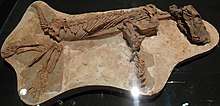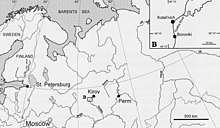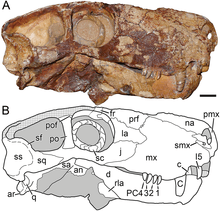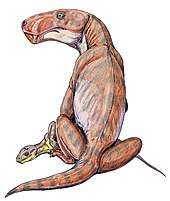Viatkogorgon
Viatkogorgon is a genus of gorgonopsian therapsid that lived during the Permian of what is now Russia.
| Viatkogorgon | |
|---|---|
 | |
| Holotype skeleton exhibited in Dinosaurium, Prague | |
| Scientific classification | |
| Kingdom: | Animalia |
| Phylum: | Chordata |
| Clade: | Therapsida |
| Family: | †Gorgonopsidae |
| Genus: | †Viatkogorgon Tatarinov, 1999 |
| Type species | |
| Viatkogorgon ivachnenkoi Tatarinov, 1999 | |
Discovery

In 1999, the palaeontologist Leonid P. Tatarinov named the new genus and species of gorgonopsian Viatkogorgon ivachnenkoi. The generic name refers to the Vyatka River, and to Gorgonops, the name of a related genus. The name "gorgon" is often used in the generic names of gorgonopsians, referring to the monstrous hags of Greek mythology. The specific name honours the palaeontologist Mikhail F. Ivakhnenko. The holotype specimen (catalogued as PIN 2212/61 in the Paleontological Institute of the Russian Academy of Sciences, Moscow) was found at the Kotelnich locality (which consists of a series of Permian exposures on the banks of the Vyatka River) of Kotel’nichskii District, in the Kirov Region of Russia. The holotype is one of the most complete gorgonopsian specimens in the world, and preserves almost the entire postcranial skeleton, including elements that are rarely preserved intact in therapsids, such as the gastralia ("belly ribs"). The skull is relatively poorly preserved in comparison, with the left side and the palate badly broken, and the skull roof is reconstructed in plaster, except for the snout tip and left postorbital bone. Overall, the skull is also compressed from side to side, which makes it narrower than it would have been in life when viewed from above.[1][2]
Tatarinov only described the skull in the original description (wherein he also named the new genus scylacosaur Kotelcephalon) because the article was restricted in volume, but preliminarily described the postcranium in 2004. In their 2018 re-description of the skull, the palaeontologists Christian F. Kammerer and Vladimir Masyutin stated that a detailed description of the postcranium would greatly improve understanding of the skeletal anatomy of gorgonopsian, but it was unavailable for study during their research, due to being part of a travelling exhibition.[1][3][2]
Description


It was a small animal, with well developed gastralia, short legs, and widespread limbs.[3]
Palaeobiology
Some of its features suggest that it may have been a good swimmer.[3] Viatkogorgon was a small predator, unlike later gorgonopsians which were large-bodied apex predators.[4]
References
- Tatarinov, L. P. (1999). "New Theriodonts (Reptilia) from the Late Permian Fauna of the Kotelnich Locality, Kirov Region". Paleontological Journal. 5 (33): 550–556.
- Kammerer, C. F.; Masyutin, Vladimir (2018). "Gorgonopsian therapsids (Nochnitsa gen. nov. and Viatkogorgon) from the Permian Kotelnich locality of Russia". PeerJ. 6: e4954. doi:10.7717/peerj.4954.
- Tatarinov, L.P. (July 2004). "A postcranial skeleton of the gorgonopian Viatkogorgon ivachnenkoi (Reptilia, Theriodontia) from the Upper Permian Kotelnich locality, Kirov Region". Paleontological Journal. 38 (4): 437–447 – via ResearchGate.
- Kammerer, C. F.; Masyutin, V. (2018). "A new therocephalian (Gorynychus masyutinae gen. et sp. nov.) from the Permian Kotelnich locality, Kirov Region, Russia". PeerJ. 6: e4933. doi:10.7717/peerj.4933.
